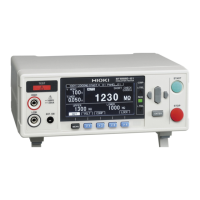115
Using the RS-232C Interface
Set the controller (computer or PLC, etc.).
Make sure to set the controller as shown below.
• Start-stop synchronization
• Transfer speed: 9,600 bps / 19,200 bps / 38,400 bps (Set to match the instrument
setting.)
• Stop bit: 1
• Data length: 8
• Parity check: None
• Flow control: None
Connecting the RS-232C cable
Connect the RS-232C cable to the RS-232C connector. When connecting the cable,
be sure to tighten the connector in place with screws.
9-pin D-sub male
with #4-40 screw lock
assembly
1 2 3 4 5
6 7 8 9
Rear panel
To connect the instrument to a controller (DTE), use a crossover cable compatible
with the connectors on the instrument and the controller.
The I/O connector is a terminal (DTE) conguration.
This instrument uses pin numbers 2, 3, and 5. Other pins are not connected.
Pin No.
Signal name
Signal Remarks
Common EIA JIS
1 DCD CF CD Carrier detect Not used
2 RxD BB RD Receive data
3 TxD BA SD Transmit data
4 DTR CD ER Data terminal ready ON level (+5 to +9 V) xed
5 GND AB SG Signal ground
6 DSR CC DR Data set ready Not used
7 RTS CA RS Request to send ON level (+5 to +9 V) xed
8 CTS CB CS Clear to send Not used
9 RI CE CI Ring indicator Not used
10
9
8
7
6
5
4
3
2
1
Appx. Ind.

